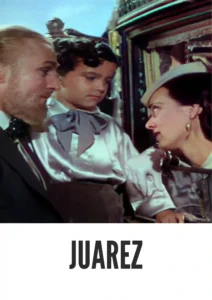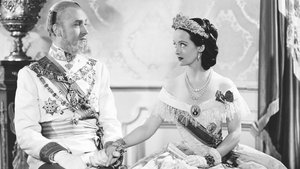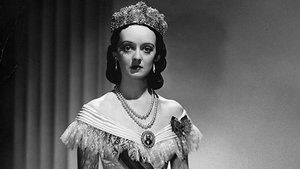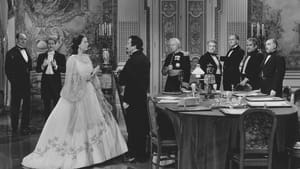Contact: info@alwanfilm.com
Video Sources 0 Views

Synopsis
Juarez 1939 Colorized Review: A Historical Drama Brought to Life in Color

Introduction
Released in 1939, Juarez is a historical drama directed by William Dieterle, known for his mastery in biographical storytelling. The film offers an in-depth look at the life of Benito Juárez, a pivotal figure in Mexican history, as he battles foreign intervention during the French occupation of Mexico. With its star-studded cast, including Paul Muni as Juárez, Bette Davis as Empress Carlota, and Brian Aherne as Emperor Maximilian, the film brings to life a turbulent period in 19th-century Mexico. Originally filmed in black and white, Juarez has since been colorized, providing a new visual dimension to this gripping historical narrative.
In this review, we’ll explore the impact of the film’s colorization on its viewing experience, delve into the powerful performances by its cast, and discuss how Juarez remains a significant cinematic work. We’ll also examine the controversy surrounding film colorization and the ongoing debate over its effects on classic films.
Check The Full Colorized Movies List
Check Our Colorized Movies Trailer Channel
Understanding Juarez 1939 Colorized: Director, Cast, and Genre
Director’s Vision
William Dieterle, already a celebrated director by the time Juarez was released, brought his extensive experience with historical films to this project. His earlier works, such as The Life of Emile Zola (1937), demonstrated his talent for crafting detailed biopics that capture both the personal and political struggles of historical figures. In Juarez, Dieterle once again excels, weaving together a complex narrative that highlights the interplay of personal ambition, political intrigue, and moral conviction.
Dieterle’s directorial vision for Juarez was to create a sweeping historical epic that not only captured the grandeur of the events but also focused on the intimate struggles of its characters. His ability to balance these elements is one of the film’s strengths, allowing audiences to connect with both the larger historical context and the personal stories of the key players.
The Iconic Performance of Actors
The cast of Juarez is one of its most impressive features. Paul Muni’s portrayal of Benito Juárez is a masterclass in acting, embodying the Mexican president’s stoic resolve and unyielding sense of justice. Muni’s performance anchors the film, providing a powerful counterpoint to the more flamboyant and tragic figures of Emperor Maximilian and Empress Carlota.
Bette Davis, as Empress Carlota, delivers a mesmerizing performance that captures the character’s descent into madness as her empire crumbles around her. Davis’ portrayal of Carlota is both sympathetic and terrifying, making her one of the most memorable characters in the film.
Brian Aherne’s portrayal of Emperor Maximilian is equally compelling, offering a nuanced depiction of a ruler torn between his ideals and the harsh realities of political power. Aherne’s Maximilian is a tragic figure, a man who genuinely wishes to bring reform to Mexico but is ultimately undone by his own hubris and naivety.
Exploring the Genre
Juarez (1939) is a historical drama, a genre that was popular in the 1930s and 1940s. Historical dramas of this era often focused on significant political figures and events, offering audiences a blend of educational content and entertainment. The genre allows filmmakers to explore complex themes such as power, morality, and justice, all of which are central to Juarez.
In this film, the drama is amplified by the high-stakes political environment in which the story unfolds. The clash between Juárez’s vision for a free and independent Mexico and Maximilian’s ill-fated reign creates a narrative rich in tension and emotion. Juarez stands as one of the more sophisticated historical dramas of its time, offering a thoughtful exploration of its subject matter while still delivering the grandeur audiences expected from films of this genre.
Exploring the World of Juarez 1939 Colorized: Plot and Characters
Detailed Synopsis
Juarez (1939) focuses on the conflict between Benito Juárez, the president of Mexico, and Emperor Maximilian, who was installed as a puppet ruler by French Emperor Napoleon III. The film begins by introducing Juárez as a man of principle, determined to rid Mexico of foreign control and establish a republic. Meanwhile, Maximilian, portrayed as an idealistic but misguided figure, is manipulated by Napoleon III into accepting the throne of Mexico.
As the story progresses, Juárez and Maximilian become locked in a struggle for control of the country. Juárez, with the support of his loyal followers, wages a guerrilla war against the French forces and Maximilian’s regime. Maximilian, though well-intentioned, becomes increasingly isolated as his reign falters. His wife, Empress Carlota, descends into madness as she realizes that their imperial dream is unraveling.
The film culminates in Maximilian’s eventual defeat and execution, while Juárez emerges victorious, having preserved Mexican independence. The characters’ personal journeys—Juárez’s steadfast commitment to his people, Maximilian’s tragic idealism, and Carlota’s emotional breakdown—are woven into the broader historical narrative, creating a rich and compelling drama.
Complex Protagonists and Memorable Supporting Characters
One of the strengths of Juarez is its deep character development. Benito Juárez is portrayed not as a flawless hero but as a man of conviction whose strength lies in his unwavering dedication to his country. Paul Muni’s performance brings out Juárez’s quiet determination and his inner struggles, making him a relatable and sympathetic figure.
In contrast, Maximilian and Carlota are depicted as tragic figures, whose downfall is as much a result of their personal failings as it is of external forces. Brian Aherne’s Maximilian is a man caught between his desire to reform Mexico and the reality that his position is unsustainable. Bette Davis’ Carlota, meanwhile, is a woman driven to madness by the collapse of her dreams, her performance offering a poignant exploration of mental deterioration.
Supporting characters, including the French ambassador and Juárez’s allies, add depth to the story, each representing different facets of the political landscape. The interplay between these characters adds complexity to the film, ensuring that it is not just a simple tale of good versus evil but a nuanced exploration of power and morality.
The Art of Film Colorization
Understanding the Process
Film colorization, particularly for a historical drama like Juarez, is a delicate art that requires careful attention to detail. The goal is to add color to the film in a way that enhances the viewing experience without compromising the integrity of the original black-and-white aesthetic. Colorization techniques have evolved over the years, with early methods involving hand-painting each frame. Today, digital technology allows for more precise and lifelike colorization, making the process both more efficient and more accurate.
In the case of Juarez, the colorization process involved extensive research into the historical period to ensure that the colors used in the costumes, sets, and environments were as authentic as possible. This attention to detail is crucial in a film like Juarez, where the visual representation of historical figures and events is a key part of the storytelling.
Development Over Time
The colorization of films has a long and controversial history. Early attempts at colorization were often criticized for being overly simplistic or for distorting the director’s original vision. However, as technology has improved, so too has the quality of colorization. Today, colorized versions of classic films can offer a fresh perspective, allowing new audiences to experience these films in a way that feels more contemporary.
In the case of Juarez, the colorization adds a new layer of visual richness to the film. The vibrancy of the costumes and the Mexican landscapes is brought to life in a way that was not possible in the original black-and-white version. However, this also raises questions about how the colorization affects the tone and mood of the film, which was originally crafted with the stark contrast of black and white in mind.
Early Colored Films: A Brief History
Emergence of Early Colored Techniques
The evolution of color in cinema began long before the advent of digital colorization. Early filmmakers experimented with tinting and toning, adding single colors to specific scenes to evoke mood or symbolize certain themes. Later, processes such as Technicolor revolutionized the industry by allowing filmmakers to produce vibrant, full-color films.
By the late 1930s, when Juarez was released, Technicolor was already being used in major Hollywood productions. However, many films, particularly historical dramas, continued to be produced in black and white due to budget constraints or aesthetic choices. Juarez was one such film, and its original black-and-white presentation gave it a certain gravitas and historical weight that aligned with its serious subject matter.
Juarez 1939 and Its Early Colored Version
The Decision to Release in Color
The decision to colorize Juarez decades after its original release was likely motivated by a desire to introduce the film to a new generation of viewers. By adding color, the filmmakers hoped to make the film more visually appealing to modern audiences who may be less accustomed to black-and-white films. The colorized version provides a new way to experience the film, highlighting aspects of the production design that may have been less noticeable in the original release.
Impact on the Visual Narrative
The colorization of Juarez enhances certain elements of the film, particularly the costumes and sets. The rich colors of the Mexican landscapes, the opulent royal attire of Maximilian and Carlota, and the vivid details of the historical settings are brought to life in a way that adds visual depth to the story. However, for some viewers, the colorization may detract from the original mood of the film, which was intended to convey the stark contrast between the characters’ ideals and the harsh realities of their world.
The Debate Over Film Colorization
Controversy Surrounding Colorizing Black-and-White Films
The colorization of classic films like Juarez has long been a subject of debate among filmmakers, critics, and audiences. On one hand, colorization can breathe new life into older films, making them more accessible and visually engaging for modern viewers. On the other hand, purists argue that colorization can undermine the artistic intent of the original filmmakers, particularly when a film was deliberately shot in black and white.
In the case of Juarez, some critics have expressed concern that the colorization alters the film’s tone, shifting it from a serious historical drama to something more visually vibrant but potentially less weighty. Others, however, argue that the colorized version provides a new way to appreciate the film’s historical details and production design.
Examining Juarez 1939 as an Early Colored Film
Enhancing or Detracting from the Experience?
Whether the colorization of Juarez enhances or detracts from the viewing experience ultimately depends on the perspective of the viewer. For those who appreciate the added visual dimension, the colorized version offers a fresh take on the film, highlighting its lavish production values and historical settings. For others, the colorization may feel like an unnecessary alteration that detracts from the film’s original aesthetic and emotional tone.
What remains clear, however, is that the colorization of Juarez has sparked renewed interest in the film, encouraging both new and longtime fans to revisit this historical epic and engage with its timeless themes of justice, power, and sacrifice.
Influence and Legacy: Juarez 1939 Colorized’s Impact on Cinema
Historical Films in Hollywood
Juarez (1939) holds a special place in the history of Hollywood’s historical dramas. Its detailed portrayal of a significant moment in Mexican history, combined with its powerful performances and ambitious scope, set a standard for future films in the genre. The success of Juarez helped pave the way for other large-scale historical dramas, particularly those that focus on the lives of political leaders and the complex dynamics of power.
Director’s Cinematic Legacy: Beyond Juarez 1939 Colorized
William Dieterle’s Influence on Filmmaking
William Dieterle’s work on Juarez is part of his larger legacy as a director of historical films. His ability to balance the personal and political aspects of his subjects has made him one of the most respected directors of his time. Beyond Juarez, Dieterle’s other films, including The Hunchback of Notre Dame (1939) and The Life of Emile Zola, continue to be celebrated for their cinematic craftsmanship and emotional depth.
Dieterle’s influence can be seen in the work of later filmmakers who have tackled historical subjects, particularly those who strive to humanize their protagonists while still addressing the broader political and social implications of their stories.
Themes Explored in Juarez 1939 Colorized
Power, Justice, and Sacrifice
At its core, Juarez (1939) is a film about power—how it is obtained, wielded, and ultimately lost. The film explores the different ways in which its characters approach power: Juárez sees it as a means to liberate his people, while Maximilian views it as an opportunity to bring reform, though he is ultimately corrupted by his position.
The theme of justice is central to Juárez’s character, as he fights to uphold the ideals of democracy and self-determination. His unwavering commitment to justice stands in stark contrast to Maximilian’s tragic arc, where the pursuit of power leads to betrayal and ruin.
Sacrifice is another important theme in the film, as both Juárez and Maximilian make personal sacrifices for their respective causes. For Juárez, it is the sacrifice of personal safety and comfort in the name of national freedom, while for Maximilian, it is the ultimate sacrifice of his life, misguided as his intentions may have been.
Reception and Controversy Surrounding Juarez 1939 Colorized
Initial Critical Reception
Upon its release, Juarez (1939) received critical acclaim for its performances and historical accuracy. Paul Muni’s portrayal of Juárez was especially praised, with many critics noting his ability to convey the quiet strength and moral conviction of the Mexican leader. Bette Davis also received accolades for her intense and emotionally charged performance as Carlota.
The film’s meticulous attention to historical detail, combined with its engaging narrative and strong performances, helped it stand out in a year filled with major cinematic releases, including Gone with the Wind and The Wizard of Oz.
Controversy Over Colorization
As with many films that have been colorized after their initial release, Juarez has faced some controversy over whether the addition of color alters the film’s original artistic intent. While some viewers appreciate the visual richness that colorization brings, others feel that the film’s original black-and-white presentation better suited its serious tone and historical subject matter.
Where to Watch Juarez 1939 Colorized Online
For those interested in watching Juarez (1939), the film is available on several streaming platforms, including Amazon Prime Video, Turner Classic Movies, and various on-demand services. Both the original black-and-white version and the colorized edition can be found, allowing viewers to choose how they want to experience this historical drama.
FAQs About Juarez 1939 Colorized
Q: What is the significance of Juarez (1939) in film history?
A: Juarez (1939) is a significant historical drama that explores the life of Benito Juárez, a key figure in Mexican history, and his struggle against Emperor Maximilian during the French occupation of Mexico. The film is notable for its strong performances and its portrayal of complex political and personal themes.
Q: Who stars in Juarez (1939)?
A: The film stars Paul Muni as Benito Juárez, Bette Davis as Empress Carlota, and Brian Aherne as Emperor Maximilian.
Q: What is the controversy surrounding the colorized version of Juarez?
A: The colorized version of Juarez has sparked debate among critics and viewers, with some appreciating the added visual appeal and others feeling that the original black-and-white presentation better suited the film’s tone.
Q: Where can I watch Juarez (1939)?
A: Juarez (1939) is available for streaming on platforms such as Amazon Prime Video and Turner Classic Movies, as well as on DVD and Blu-ray.
Conclusion
Juarez (1939) remains a powerful historical drama that captures a pivotal moment in Mexican history. With its strong performances, particularly by Paul Muni and Bette Davis, and its thoughtful exploration of themes such as power, justice, and sacrifice, the film continues to resonate with audiences today. The colorized version offers a new way to experience the film, adding a layer of visual depth while sparking debate about the merits of film colorization.
Whether viewed in its original black-and-white format or the colorized version, Juarez stands as a testament to the enduring power of historical drama in cinema and the lasting legacy of its director, William Dieterle.
















